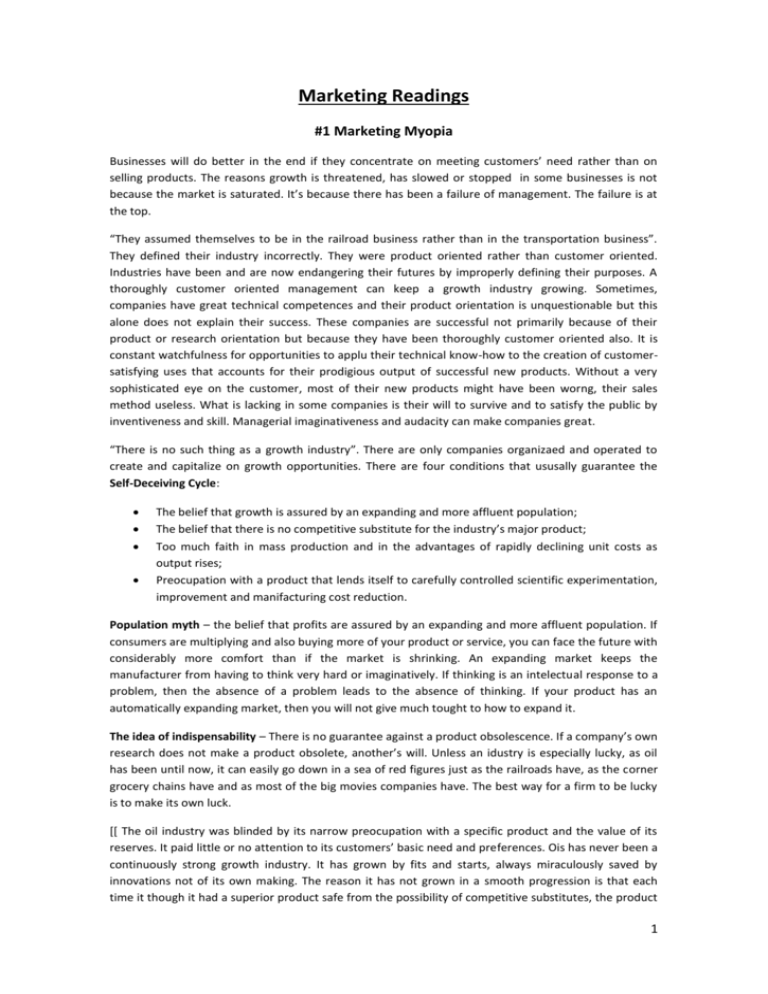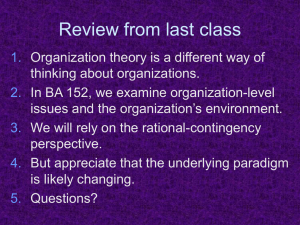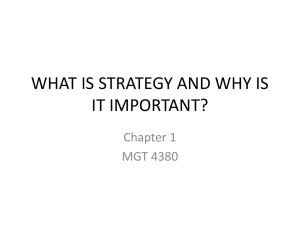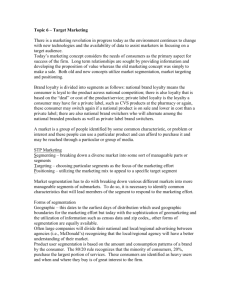Marketing Readings
advertisement

Marketing Readings #1 Marketing Myopia Businesses will do better in the end if they concentrate on meeting customers’ need rather than on selling products. The reasons growth is threatened, has slowed or stopped in some businesses is not because the market is saturated. It’s because there has been a failure of management. The failure is at the top. “They assumed themselves to be in the railroad business rather than in the transportation business”. They defined their industry incorrectly. They were product oriented rather than customer oriented. Industries have been and are now endangering their futures by improperly defining their purposes. A thoroughly customer oriented management can keep a growth industry growing. Sometimes, companies have great technical competences and their product orientation is unquestionable but this alone does not explain their success. These companies are successful not primarily because of their product or research orientation but because they have been thoroughly customer oriented also. It is constant watchfulness for opportunities to applu their technical know-how to the creation of customersatisfying uses that accounts for their prodigious output of successful new products. Without a very sophisticated eye on the customer, most of their new products might have been worng, their sales method useless. What is lacking in some companies is their will to survive and to satisfy the public by inventiveness and skill. Managerial imaginativeness and audacity can make companies great. “There is no such thing as a growth industry”. There are only companies organizaed and operated to create and capitalize on growth opportunities. There are four conditions that ususally guarantee the Self-Deceiving Cycle: The belief that growth is assured by an expanding and more affluent population; The belief that there is no competitive substitute for the industry’s major product; Too much faith in mass production and in the advantages of rapidly declining unit costs as output rises; Preocupation with a product that lends itself to carefully controlled scientific experimentation, improvement and manifacturing cost reduction. Population myth – the belief that profits are assured by an expanding and more affluent population. If consumers are multiplying and also buying more of your product or service, you can face the future with considerably more comfort than if the market is shrinking. An expanding market keeps the manufacturer from having to think very hard or imaginatively. If thinking is an intelectual response to a problem, then the absence of a problem leads to the absence of thinking. If your product has an automatically expanding market, then you will not give much tought to how to expand it. The idea of indispensability – There is no guarantee against a product obsolescence. If a company’s own research does not make a product obsolete, another’s will. Unless an idustry is especially lucky, as oil has been until now, it can easily go down in a sea of red figures just as the railroads have, as the corner grocery chains have and as most of the big movies companies have. The best way for a firm to be lucky is to make its own luck. [[ The oil industry was blinded by its narrow preocupation with a specific product and the value of its reserves. It paid little or no attention to its customers’ basic need and preferences. Ois has never been a continuously strong growth industry. It has grown by fits and starts, always miraculously saved by innovations not of its own making. The reason it has not grown in a smooth progression is that each time it though it had a superior product safe from the possibility of competitive substitutes, the product 1 turned out to be inferior and notoriously subject to obsolence. Management might be more likely ro do what is needed for its own preservation if it thought of itself as being in the energy business, not in the oil business. But even that will not be enough if it persists in imprisoning itself in the narrow grip of its tight product orientation. It has to think of itself as taking care of customer needs, not finding, refining or even selling oil. ]] Production Pressures – Mass production industrues are impelled by a great drive to produce all they can. The prospect of steeply declining unit costs as output rises is more than most companies can usually resist. The profit possibilities look spectacular. All effort focuses on production. The result is that marketing gets neglected. Mass production does indeed generate great pressure to “Move” the product. But what usually gets emphasized is selling, not marketing, which is more a sophisticated and complex process that is ignored. Selling focuses on the need of the seller, marketing on the needs of the buyer. Selling is preocupied with the seller’s need to convert product into cash, marketing with the idea of satisfying the needs of the customer by means of the product and the whole cluster of things associated with creating, delivering and consuming it. A truly marketing-oriented firm tries to create value-satisfying goods and services that consumers will want to buy. Mos important, what it offers for sale is not determined by the seller, but by the buyer. The seller takes cues from the buyer in such a way that the product becomes a consequence of the marketing effort, not the other way around. [[ Automobile industry example. Detroit never really researched customer wants. It only researched their preferences between the kinds of things it already had decided to offer them. The automobile industry does not seem to listen or to take cues from the anguished consumer. If they do listen, it must be thorugh the filter of their own preocupation with production. The marketing is still viewd as a consequence of the production. Henry Ford is usually celebrated for his production genius. His real genius was marketing. We think he was able to cut his selling price and therefore sell millions of cars because of his invention of the assembly line had reduced the costs. Actually, he invented the assembly line because he had concluded that, in order to sell millions of cars, he had to drop the price. Mass production was the result, not the cause, of his low prices. ]] The usual result of this narrow preoccupation with so-called concrete matters is that instead of growing, the industry declines. It usually means that the product fails to adapt to the consumer changing patterns of consumer needs and tastes, to new and modified marketing institutions and practices, or product developments in competing or complementary industries. The industry has its eyes so firmly on its own specific products that it does not see how it is being made obsolete. Companies have to develop their products before their competitors do, so they will not be companies without an industry. It is not surprising that, having created a successful company by making a superior product, management continues to be oriented towards the product rather than the people who consume it. Danger of R&D – Another big danger to a firm’s continued growth arises when top management is wholly transfixed by the profit possibilities of technical research and development. The organization tends to see itself as making things rather than as satisfying customer needs. Marketing gets treated as a residual activity. These businesses lend themselves to careful study, experimentation and control. What gets shortchanged are the realities of the market. Consumers are unpredictable, varied, fickle, stupid, shortshighted, stubborn and generally bothersome. These companies know what they can control, namely product, research, engineering and production. The emphasis on production becomes particularly attractive when product can be made at declining unit costs. These companies are in the felicitous position of having to fill, not find, markets, of not having to discover what the consumer needs and wants but of having the consumer voluntarily come forward with specific new product demands. [[ In the case of electronics, the greatest danger that faces the glamourous new companies in this field is not that they do not pay enough attention to research and development, but that they pay too much 2 attention to it. Their success has been shaped in the virtually guaranteed market of military subsidies and by military orders. Their expansion has been almost totally devoid of marketing effort. They are growing under conditions that are coming dangerously close to creating the illusion that a superior product will sell itself. It develops the philosophy that continued growth is a matter of continued product innovation and improvement. ]] The view that and industry is a customer-satisfying process, not a goods-production process, is vital for all business people to understand. An industry begins with the customer and his needs. Given the customer’s needs, the industry develops backwards, first concerning itself with the physical delivery of customer satisfaction. Then it moves back further to creating things by which these satisfactions are in part achieved. Finally, the industry moves back even further to find the raw materials necessary to making its products. Selling is not marketing. Selling concerns itself with the tricks and techniques of getting people to exchange their cash for your product. Marketing views the entire business process as consisting of a tightly integrated effort to discover, create, arouse and satisfy customer needs. Building an effective customer-oriented company involves profound matters of human organization and leadership. The company has to adapt to the requirements of the market, and it has to do it sooner rather than later. There need to be will to succeed. 3 #2 A Note on Consumer Market Segmentation The goal of market segmentation is to partition the total market for a product or service into smaller groups of consumer (segments) based on their characteristics, their potential as consumers for the specific product or service in question and their different reactions to marketing strategies. Segmentation seeks to isolate significan differences among groups of individuals in the market. Helps the marketer to target more effectively marketing efforts; Provides understanding of these customers and helps tailoring strategies; Aids in the implementation of the marketing concept because the marketer is able to address and satisfy consumer needs more effectively; On-going consumer analysis and market segmentation provides important data on which longrange planing can be based. Segmentation is not appropriate in every marketing situation, for example, if the market is undifferentiated one “mass” marketing strategy would probably be appropriate. But nowadays it is unlikely one would either find either an entirely homogeneous or heterogeneous consumer market. There are cluster of customers that are relatively homogeneous with regard to their perceptions, needs and behaviors towards a type of product or service, and that behave similarly.when it comes to marketing strategy. Each different market segment can be thought of having its own market demand curve. When the structure of the segmentation is understood, the marketer can either select the best target segment for his brand and ignore others or develop different marketing strategies designed to reach and influence different market segments. The segmentation philosophy is a powerful tool to reduce the marketer’s risk in the marketplace. Market segmentation assumes that because consumption behavior is not random it is possible to identify and isolate groups of individuals who demand different kinds of product characteristics and react differently to specific marketing strategies. After careful analysis, the marketer is willing to select target segments whose needs he can best fulfill, and concentrate efforts in reaching and persuading primarily this portion of the total market. The marketer is willing to design different marketing strategies for each segment. Because the market segments will react differently to marketing strategies and tactics they should be: Homogeneous – similar in behavior; Identifiable – there should be a measurable and meaningful factor; Accessible – can be reached by advertising and distribution channels; Effective Demand – large enough and ability to purchase. The best way to begin segmentation analysis is to find consumer dimensions that can be most clearly predictive of probable purchase and use of the product or service in question. Segmentation dimensions fall into two broad classes: (1) Consumer’s Background Characteristics and (2) Consumer’s Market History: Consumer Background Characteristics – describes who the consumer is as an individual. Geography (region, mobility, cultural differences in habits or tastes), Demographic (age, sex, income, education, social status), Psychographic (personality traits, perceptual styles, reference groups, attitudes about self, society, family), and General Lifestyle (activities, interests) 4 Consumer Market History – describes what consumers have done in the marketplace. Product Usage (frequency of brand/product use, brand loyalty, attutudes towards product), Product Benefit (expectations of product performance, needs it must fill, perception of brands, satisfaction measures) and Decision-Process (shopping patterns, media-use platforms, product information searches, sensitivity to price, dristribution or promotions). In most cases, the final definition of market segments will be most heavily besed on the one or two factors (usualy one from each category) that are most closely related to probable purchase. However, just because there are individuals in the market with different demographic or market behavior profiles, there may not be true market segments. Segmentation dimensions must provide not only clear and measurable distinctions among consumer groups, but they must also help predict differences in consumers’ reactions to the marketing strategies to be developed. Also, segmentation analysis is an iterative process. For it to be reflective of reality it must be re-assessed and redifined as new market data are available or as the competitive situation changes. 1. 2. 3. 4. 5. 6. 7. Define the purpose and scope of segmentation Analyze total market data Develop segment profiles Evaluate segmentation Select target segments Design the marketing strategy for the target segment Reappraisal of segmentation Segmentation helps the marketer to reduce his risk in the marketplace in two ways. First, by providing a rich profile of target consumers, it helps customize marketing strategies for maximum impact. Second, market segmentation analysis is very useful as a planning tool to identify “open” segments and potential market opportunities, and to develop a “picture” of the consumer market for new product and market development. 5 #3 Segmenting the Base of the Pyramid If a company embarks on an initiative that focus solely on commercial gain, civil society and governments are likely to oppose to it intensely. If a company tries to stay under the radar by keeping its base-of-the pyramid operations small, profits are likely to be meager. And even if you focus mainly on social impact and consider profits secondary, the base of the pyramid is a risky place. Decent profits can be made at the base of the pyramid if companies link their own financial success with that of their constituencies. As companies make money, the communities in which they operate must profit by, for example, acquiring basic services or growing more affluent. This leads to more income and consumption and triggers more demand within the communities, which in turn allows the companies’ businesses to keep growing. The local communities’ growing economic health boosts profits and prosperity for everyone along the value chain. Those with skill at simultaneously building private and public value tend to have a nuanced understanding of their constituencies. Companies must commit to learning what constitutes value for the various components of the population. Segmenting by Living Standard - Low income: $3 and $5 a day – have some education and skills to enter the job market. Subsistence: $1 and $3 a day – poorly educated and low skilled. Their earnings are not steady. Extreme poverty: below $1 a day – lack basic necessities. Segmenting by Value-Creation Role Consumers: Companies can provide value for consumers by directly addressing their need for services such as clean water, better sanitation, education and credit. A more indirect way is to introduce innovations that enable people to devote fewer resources to basic activities and more to other pursuits. People at the base of the pyramid often turn out to be paying premiums for, and wasting a great deal of time on, products and services that are shoddy at best. So there’s significant room for innovative businesses to provide good-quality offerings with lower overall usage costs and greater convenience. The result is a profound effect on productivity. Casting people in the role of consumers is often more appropriate in the low-income segment. Coproducers: When a company views base-of-the-pyramid residents as coproducers it provides them with work and income. Companies can give people training and technical knowledge to upgrade the quality of their output and reward them with greater monetary returns. Engaging people as coproducers is most appropriate in the subsistence segment because earning some additional income is their primary need. With this extra money, they can try to improve the quality of their consumption. Individuals in the extreme poverty segment are not potential coproducers because they are too difficult to access or don’t have the necessary skills. Clients: A significant portion of the population at the base of the pyramid, primarily in the extreme-poverty segment, are most appropriately treated as clients. The reality is that they need “agents” so to speak, to garner resources on their behalf. The government can serve as an agent, as can a civil society institution, a community organization or a commercial enterprise. Missteps at the Base of the Pyramid Too often companies assume that their responsibilities end once they have provided a needed product or service, or have engaged people as suppliers or workers. That attitude leaves companies vulnerable to criticism. Companies, aside from working within and with this communities, can commit to add social 6 value by conducting profits for clients’ health care or skills development in order to boost their quality of living. How to Entwine Commercial and Social Value Many companies have simultaneously created private and public value in part through innovative business models that enlist community members or organizations in distribution, access, payment or security activities. Ensuring that such a model is both commercialy feasible and sustainable over the long term involves streamlining operations and designing appropriate incentives for the people who are brought into the economic ecosystems that the companies have created. - - In the low-income segment [[ check examples ]]; In the subsistence segment: people often lack essential information about new products or methods and are reluctant to adopt them. Companies must create demand for entire cetegories of products, by educating customers and accessing them through the most appropriate channels. Some companies, even while selling products and services to customers higher up in the pyramid, create tremendous value by extensively engaging the subsistence segment in their supply chains. In the extreme-poverty segment: here, where delivering basic services such as water, sanitation, health care and education requires heavy investments, companies have little choice but to enter into public-private partnerships that provide guarantees on cost recovery, subsidies, and market exclusivity. Without partnerships, opportunities for profits are few, even in the long run. Because the needs of the extreme-poverty segment are for the basics, a company should be careful to earn the community’s trust by providing outstanding value, and that value should be the engine of profitability. Businesses should also not overlook the advantages of teaming up with NGOs. A strategy of creating private and public value while aiming for scale gives companies their best chance to succeed. Commercial and social value are like the two blades of a pair of scissors, and scale is like the tailor’s deft hand. You must have all three elements to slice the knotty obstacles at the base of the pyramid. 7 #4 Analyzing Consumer Perceptions An important input to marketing decision making is an understanding of how consumers “see” the firm, brand or product relative to competitors. In setting an objective of a particular “product positioning” in the mind of consumers, marketers want to check whether or not the desired positioning has in fact been achieved. This helps them assess whether the current strategy is on target or if some “repositioning” is necessary. Perceptual data is critical in diagnosing companies’ problems and suggesting the most benefitial type of strategy change. When analyzing perception data (what people see) as opposed to preference data (what people like) marketers are more willing to live with an assumption of homogeneity in responses across consumers. Data Collection and Profile Analysis: there is a variety of ways in which to collect perception data, as for example asking consumers to provide a rating to indicate the extent to which the agree with certain statements. Data can be easily summarized by averaging it across all survey respondents and plots such as “snake plots” help giving insight into consumers’ opinios, for example about a company relative to its competitors. However, as the number of brands to be considered increases, snake plots can become a mess to interprete. This is why perceptual mapping techniques have been developed and are widely used. Perceptual Mapping Techniques: when consumers’ perceptions of multiple competitors on multiple dimensions is of interest, more powerful analysis techniques help to make the data more meaningful. The output is a map of brands depicted in attribute space. There are two types of mapping procedures, depending on the type of data collected form consumers: (i) ratings of items on prespecified attributes and (ii) judgements on overall similarity of paired brands. The second method is particularly useful when articulating the attributes is difficult. (i) (ii) Attribute Rating Method – The statistical procedure underlying this type of perceptual mapping is either factor analysis or discriminant analysis. Sometimes the maps cannot capture all the variations among brands or products. However, it does the best it can, retaining the most important information, and reporting it in two dimensions to provide visual impact. This method is good for applications with “hard attributes” but has key limitation for certain product types whose attributes we cannot verbalize well. Overall Smilarity Method – In this method the respondent makes judgements about the overall similarity of pairs of items. This allows us not only to map products but also infer the attributes used by the respondents in making distinctions. The statistical technique used is multidimensional scaling and the output is given in relative positions so the axes must be interpreted by the analysts. There are three major ways in which perceptual maps are used in marketing: To obtain a better understanding of current positioning and market structure Marketers like to check rigorously that the desired product positioning has been attained. Understanding where we are relative to our competitors facilitates this. Also, perceptual maps can be a useful stimulus to opportunity identification as “holes” in the product space can be exploited as they may represent niches of the market which current competitors have overlooked and could be developed. Moreover, the maps indicate the vulnerability of competitors by showing how consumers perceive them. To test where a new product being considered for indtroducing would be perceived 8 Once a general opportunity has been identified, the process usually moves forward to concept developing and testing. Maps can be used to test if the concept or product would be perceived by the consumers as the firm intended. For this, respondents must be informed about the new concept or product, either through a concept statement or, if possible, product use. They can also be used after a product introduction to track the positioning. To provide direction to R&D efforts to satisfy the wants of consumers better This purpose is similar to the second one except that here we require formal representation of the “ideal point” of a customer, what point in the map represents the ideal combination of attributes for different customer groups. Perceptual mappinh has proven an extremely useful addition to the marketing analysis toolkit. But it has limitations. First, it represents a static view of consumers’ current perceptions. If it is done over time on the same market, some trends can be monitored. Second, while it may help a firm determine what it would like to do vis-à-vis the market, it provides no indication of the cost or likelihood of being able to achieve the desired positioning. 9 #5 Customer-based Brand Equity 10 #6 Strategies to Fight Low-Cost Rivals Companies must invest a lot of money, people and time to figh competitors. However, the obsession big companies have with their traditional rivals has blinded them from low-cost competitors. Such companies offer products and services at prices dramatically lower than the prices established businesses charge, often by harnessing the forces of deregulation, globalization and technological innovations. Low-cost combatants are changing the nature of competition. Mos companies behave as though low-cost competitors are no different from traditional rivals or as though they don’t matter. Ignoring cut-price rivals is a mistake because it eventually forces companies to vacate entire market segments. When market leader do respond, they often set off price wars, hurting themselves more than the challengers. But they can also face them in two ways: by becoming more deffensive and trying to differentiate their products or by launching low-cost businesses of their own. This so called dual strategy can only work if companies can generate synergies between the existing businesses and the new ventures. If they cannot, companies are better off trying to transform themselves into solution providers or into low-cost players. Successful price warriors focus on just one or a few consumer segments; they deliver the basic product or provide one benefit better than rivals do; and they back everyday low prices with super efficient operations to keep costs down. The financial calculations of low-cost players are different from those of established companies. They earn smaller gross margins than traditional players do, but their business models turn those into higher operating margins. Low-cost companies stay ahead of market leaders because consumer behavior works in their favor. If a business gets a customer to buy its products or services on the basis of price, it will lose the customer only if a rival offers a lower price. Since the discounters win all their customers because of the prices they offer, they don’t have to worry about traditional rivals that always charge premium. Only with new entrants with even lower cost structures can compete with price warriors. Most low-cost players açter consumer behavior permanently, getting people to accept fewer benefits at lower prices. Moreover, low-price warriors are aided by the fact that consumers are becoming cynical about brands, better informed because of the internet, and more open to value-for-money offers. The Futility of Price Wars – When market leaders acknowledge the threat from low-cost rivals, they usually try to match or beat their prices. Dumping is illegal in most countries and low-cost business models are designed to make money at low prices. Even when market leaders copy the critical elements of low-cost players’ business models, they are unable to match their prices. Slashing prices usually lowers profits for all incumbents without driving the low-cost entrant out of business. When Differentiation Works – When businesses finally realize they can’t win a price war with lowcost players, they try to differentiate their products in an attempt of coexistence. Companies adopt strategies such as designing cool products, continually innovate in the tradition, offer a unique product mix, brand a community and sell experiences, and they don’t use these tactics in isolation. Also, they must convince consumers to pay for benefits and the ability to do so depends os the products they sell. Many companies find it tough to persuade consumers to pay for additional benefits. A small premium for greater services or benefits os a powerful defense. All too often, though, incumbents incur huge costs in order to deliver benefits, forcing them to ask for price premiums so large that they drive away consumers. Companies must bring costs and benefits in line before implementing it and that takes time. Strategies that help an established player coexist with low-cost rivals can work initially, but as consumer become more familiar with low-cost options, they tend to migrate to them. Dealing with Dual Strategies – When companies discover that the low-price customer segment is large, they often set up low-cost ventures themselves as they believe that, due to their years of 11 experience, they can easily replicate cut-price operations, but it’s not so simple. Companies should set up low-cost operations only if the traditional operation will become more competitive as a result and the new business will derive some advantages that it would not have gained as an independent entity. New and old operations should generate synergies. A successful dual approach requires the low-cost business to use a unique brand name as this helps communicate the fewer services that go along with lower prices and it also allows customers’ expectations to form around the low-cost business model rather than the traditional operation. Creating independent units that have their own values, staff, systems and structures is necessary but not sufficient for the success of a dual strategy because common ownership often imposes constrains on low-cost operations. This strategy delivers results only when the low-cost operation is launched offensively to make money, not as a purely defensive ploy to hurt low-cost rivals. Companies should let their old and new businesses compete with one another. Switching to Conquer – If there are no synergies between traditional and low-cost businesses, companies should consider two other options: they can switch from selling products to selling solutions or convert themselves into low-cost players. o o Since low-cost players turn incumbents’ basic products into commodities, existing companies may be able to succeed by selling sollutions. By offering products and services as an integrated package, companies can expand the segment of the market that is willing to pay more for additional benefits. Solutions offer several advantages, as they include a large service component that low-cost players cannot offer due to limited product ranges and service capabilities. However, making the change is difficult. A good solution provider starts by working with customers to understand their problems before designing solutions. It is not about changing existing business models, but transforming them. Switching to a low-cost business model means acquiring capabilities that are different from the company’s existing competencies. There will always be two kinds of consumers: those who buy on basis of price and those who are partial to value. Therefore, there will always ne room for both low-cost players and value-added businesses. How much room each will have depends not only on the industry and customers’ preferences, but also on the strategies traditional businesses adopt. 12 #7 The One Thing You Must Get Right When Building a Brand There has been a rise of social media and a shift of power to consumers. However, traditional marketing activities and brands themselves will not become irrelevant. Social media make it more urgent than ever that companies get their basics right, developig and reliably delivering on a compelling brand promise. Companies that consistently deliver what they promise benefit mightily when social media amplify their reputation. However, today, the scale and speed of social media make it more riskier for companies to disappoint their customers. The obvious danger is failing to keep pace with social media development. But the less obvious danger is to get distracted by them and losing sight of the fundamentals. The companies that will succeed in this environment are exploiting the many opportunities presented by social media with an unwavering eye on their brand promise. Leverage Social Media Most companies have cottoned on the social media as tools for engagement and collaboration. Marketers at leading companies have created lively exchanges with and among customers on sites, tapping into participants’ expertise and creativity for product development. Of course, social media can also boost brand awareness, trial and ultimately sales, especially when a campaign goes viral. More important, howeverm is that through social media companies can gain very rich, unmediated customer insights, faster than ever before. This represents a profound shift as historically market research was product rather than customer-oriented. But now participants are engaged with the brands and social media provides powerful new ways to explore consumers’ lives and opinions. By developing websites were consumers can interact with the brands and among each other while being able to exchange information and opinions, companies are creating active communities by ceding some control at the same time that they use these channels to clarify expectations and to responde faster and in a more effective way to any unexpected backlashes. Enhance the Playbook All companies should incorporate social media in their marketing playbooks. Great brands share four fundamental qualities and social media can be used to reinforce all four, even as they make them more urgent: - They offer and communicate a clear, relevant customer promise; They build trust by delivering on that promise; They drive the market by continually improving the promise; They seek further advantage by innovating beyond the familiar. Companies [[ Virgin Atlantic Airways ]] scan the internet to see what people are saying and when there is misinformation they rarely have to provide corrections as site visitors usually do it themselves. They use social media to check that the brand promise is both understood and relevant. It also works to keep all its social media activities true to and in support of the brand values. Also, trust is mainly about operational execution – service delivery. But keeping customers informed when things go worn can prevent a slipup from becoming a trust-eroding PR disaster. Moreover, one of the biggest social media opportunities lies in gathering insights to drive continual incremental improvements. Social media dialogues enable companies to keep improving their offers by taking into account what customers are saying and their fresh insights online and this interaction also helps companies to appreciate important but largely unrecognized sements. Keep Your Eye on the Ball 13 Companies should start with their brand promise and let it guide all their actions in social media. They should not get distracted by the abundance of opinions. They should use social media primarily for insight as their real value at this stage is to learn about customers and not to sell things. They should strive to go viral, but protect the brand, They can improve awareness and increase sales by launching campaigns that are very entertaining andconvey authenticity and relevance but they should never be deceiving as not to engage customers in negative reactions. Finally, companies that strive for a powerful presence in social media should engage but follow the social rules. Social meida conversations about brands are usually unstructured or semiconstructed and moderated by the participants themselves, using unwritten rules. Those in the company who execute its social media strategy should naturally be at home with the culture and rules of each social network. But they must also be deeply knowledeable about the company’s products and, most important, steeped in its brand and values. 14






